
Ducati Diavel Service Manual: Reassembling the electrical components support
Check the presence of clips (1), (9) and (24) on the support (5).

Check the presence of rubber pads (6) and (8) and of cable grommet (7).
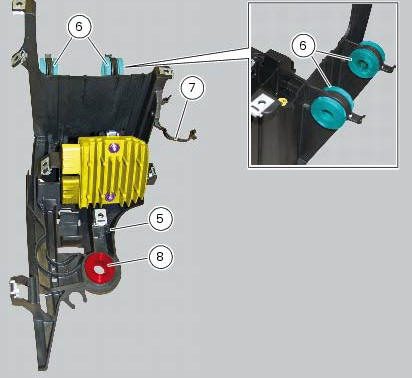
Check that the voltage regulator (3) and the solenoid starter (18) are in place on the support (5) with their wiring as shown.

The horn (22) must be fixed to the support (5) tightening the screw (25) to 18 nm +/- 10% (sect. 3 - 3, Frame torque settings).

Check the presence of the grommet (13) on the cover (12).
Fit cover (12) on the support (5) by tightening the screw (23) to a torque of 4 nm +/- 10% (sect. 3 - 3, Frame torque settings).

Fit the electrical components support (5) on the vehicle by engaging it in the retaining pin (b) on the cooler supporting bracket.
Apply the recommended threadlocker to the screw (21).
Start the screw (11) with washer (10) and the screw (21) with spacer (20).
Tighten the screw (11) to a torque of 10 nm +/-10% (sect. 3 - 3, Frame torque settings) and the screw (26) to a torque of 24 nm +/-10% (sect. 3 - 3, Frame torque settings).

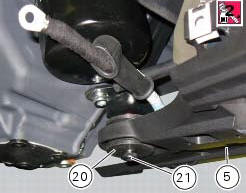
Connect the connector (a) of horn (22) to the main wiring.
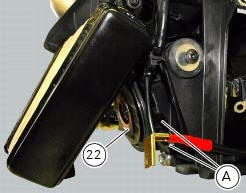
The mat (15) must be positioned as shown.
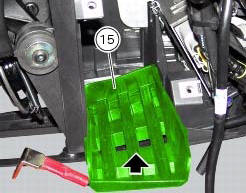

Reassemble the following elements located inside the electrical components support:
- The battery (14) as specified under section 6 - 2,battery;
- The voltage regulator (3) as specified under section 6 - 2,rectifier-regulator;
- The solenoid starter (18) as specified under section 6 - 3,solenoid starter;
After installing the battery, position the battery retaining bracket (4) by tightening the screws (32) to a torque of 5 nm +/- 10% (sect. 3 - 3, Frame torque settings).

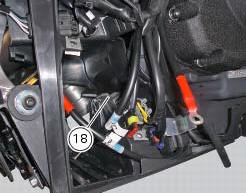
Check wiring position as described in chapter: "routing of wiring on frame", sect. 6 -1.

 Removing the electrical components support
Removing the electrical components support
Remove the following elements located inside the electrical components
support:
The battery fixing bracket (4) and the battery (14) as specified under
section 6 - 2, battery;
The voltag ...
Other materials:
Tft - parameter setting/display
Warning
Any adjustments to the dashboard must only be carried out when the
motorcycle is stationary. Never operate the
dashboard controls while riding the motorcycle.
At the end of the check, the dashboard always displays as the "main"
indication the odometer (tot) on the left and the
averag ...
External components
Oil breather valve
O-ring
Sealing washer
Gear position sensor
Cylinder barrel/head stud
Nipple
By-pass spring
Plug
Plug
Aluminium gasket
Nut
Lock washer
Timing gear pair
Key
Key
O-ring
Screw
Locating dowel
Starter idler gear
Washer
Gear shaft
O-ring
...
Key-on/key-off using the red key on the handlebar with the passive key
A key-on can be performed by pressing the red button (6) on
the handlebar in the hands free on/off position and in
the presence of the passive key (4, fig. 77).
Note
The passive key (4, fig. 77) Has a range of a few cm,
therefore the key (4, fig. 77) Must be positioned near the
antenna (2). R ...
